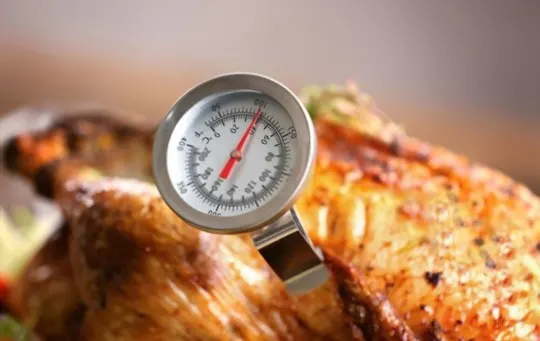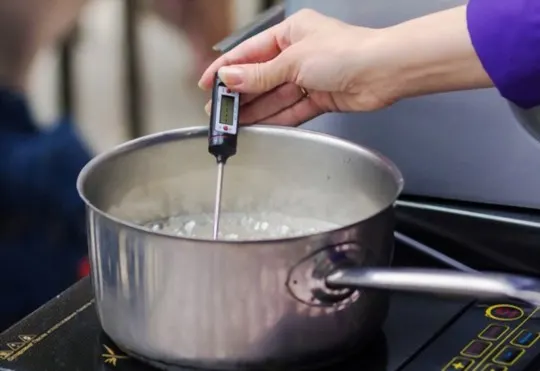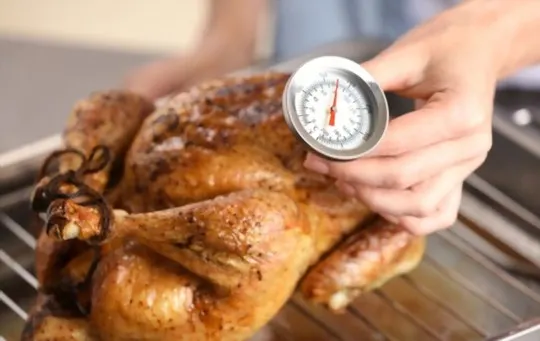Ever found yourself in the kitchen, a meat thermometer in one hand and a candy thermometer in the other?
We sure have. And man, did it feel like a standoff in a wild West movie, just less dusty and more…dinner-y.
Here’s the scoop. Meat thermometers and candy thermometers serve different masters.
The former is all about getting your steak to that perfect level of juicy goodness.
The latter? It’s your go-to for nailing that sugar syrup for Saturday’s lemonade stand.
Mixing them up could lead to a culinary showdown you didn’t sign up for.
Trust us, we learned the hard way. No one wants a caramelized roast beef.

What is a Meat Thermometer?

A meat thermometer is a device used to measure the internal temperature of cooked meat.
It ensures that the meat has reached a safe temperature and prevents undercooked or overcooked meat.
This type of thermometer typically has a pointed metal probe that is inserted into the thickest part of the meat.
Using a meat thermometer can be a more accurate way to determine if your food is safe to eat compared to other methods such as cutting into it or relying on color.
Meat thermometers come in various types, such as digital, analog, instant-read, and leave-in.
Some are even wireless and allow you to monitor the temperature remotely.
Meat thermometers are not limited to just meats; they can also be used to measure temperatures for other types of food, such as casseroles and baked goods.
However, it’s important to note that different foods require different temperature ranges.
While candy thermometers may seem similar to meat thermometers, they have different temperature ranges and are used for specific purposes like cooking sugar syrups and candies.
Candy thermometers can usually handle higher temperatures than meat thermometers but cannot accurately measure low temperatures required in cooking meats.
What is a Candy Thermometer?

Candy thermometers are specialized instruments used in cooking.
They help measure the temperature of hot liquids, specifically sugar syrups, candies, and jams.
These types of thermometers have long and pointed stems that can be clipped onto or dipped into the mixture being cooked.
The temperature readings on these thermometers usually range from 100 to 400℉ or 38 to 204℃.
With their accuracy and precision in determining temperatures, candy thermometers are indispensable for those who love to cook sweet treats such as taffies, lollipops, caramels, and fudges.
In addition to measuring temperatures during cooking processes such as making candies and jellies, candy thermometers also help identify how ‘set’ a mixture is.
By simply watching the temperature rise or fall on the thermometer over time, cooks can confirm when their confectionary concoctions have reached the right consistency and are ready for further preparation.
The stem length of a candy thermometer can be as short as six inches or as long as 12 inches depending on its specific use case.
While candy thermometers specialize in sweets-related measurements, meat thermometers are used mainly for cooking meat dishes correctly.
Meat thermometers range broadly in terms of functionalities according to different foods like beef, chicken, pork etc.
, while Candy Thermometer functions remain just about the same across foodstuffs pertaining to dessert making only.
Differences Between Meat Thermometer and Candy Thermometer

When it comes to choosing between a meat thermometer and a candy thermometer, several factors need to be considered.
One key difference is their temperature range.
A meat thermometer can measure the internal temperature of cooked meat, and typically ranges from 32°F to 212°F.
On the other hand, a candy thermometer’s temperature range is higher, measuring up to 400°F.
Another difference is their usage; a meat thermometer should be inserted into the thickest part of the meat, while candy thermometers are used for boiling sugary syrups and inserted straight into the liquid.
A crucial factor in selecting the right thermometer is accuracy.
Meat thermometers must display accurate readings within a degree or two for safe cooking; otherwise, undercooked or overcooked meat can pose health risks.
Candy thermometers too require an acceptable level of accuracy for precisely monitoring sugar temperatures needed for making fudge, caramel or brittle.
Lastly, cost also plays a vital role in determining which one to choose.
In general, meat thermometers are relatively inexpensive, while candy thermometers can be pricier due to their additional features that enable them to reach higher temperatures without damaging them.
Purpose and Function
Using thermometers is critical for achieving accurate and safe cooking results.
The purpose and function of a meat thermometer and candy thermometer vary significantly.
While a meat thermometer is designed to measure the internal temperature of meats, a candy thermometer is designed to measure the temperature of sugar solutions in confectionery making.
A meat thermometer typically has a higher temperature range than a candy thermometer, allowing it to measure temperatures up to 220°F.
A candy thermometer, on the other hand, can only measure temperatures up to 400°F.
Additionally, meat thermometers come in various forms such as instant-read or leave-in while candy thermometers are generally leave-in types.
One major difference between both types of thermometers is their accuracy.
A meat thermometer provides precise readings due to its sharp and sturdy probe which ensures proper placement inside the food.
Candy thermometers have thinner probes that may bend or shift when inserted into thicker sugary solutions.
Temperature Range
Meat thermometers and candy thermometers are both useful tools for precision cooking, but they have different temperature ranges.
While meat thermometers can typically measure temperatures up to 200 to 220 degrees Celsius, candy thermometers can handle much higher temperatures up to 300 degrees Celsius.
This is because candy-making involves heating sugar syrup to high temperatures to reach the desired consistency.
On the other hand, meat is usually cooked at lower temperatures, making a meat thermometer more suitable for this purpose.
When selecting a thermometer, it’s important to consider the temperature range you need for your cooking methods.
If you plan on making candy or any dishes that require high-temperature cooking, a candy thermometer would be a better option since it can withstand higher heat than a meat thermometer.
However, if you mainly cook meat and don’t need the high-temperature range of a candy thermometer, then investing in a good quality meat thermometer would be more practical.
It’s also worth noting that some digital thermometers have interchangeable probes for handling both low- and high-temperature cooking.
Therefore, if you frequently cook both types of dishes such as meats and candies, investing in a dual probe thermometer might be cost-effective in the long run.
Ultimately, the decision between a meat thermometer and a candy thermometer comes down to what type of cooking you will be doing most often and what temperature range your recipes require.
Probe Length and Design
When it comes to choosing between a meat thermometer and candy thermometer, the probe length and design are crucial factors to consider.
The probe of a meat thermometer is typically longer as the temperature needs to be measured deep within the meat.
On the other hand, candy thermometers have shorter probes because they only need to measure the temperature at the surface of the liquid mixture.
Moreover, the probe’s design also differs between these two types of thermometers.
Meat thermometers often come with a curved or angled probe that makes it easy to insert and read the temperature accurately.
The hardened metal probe also pierces through tough meat quickly without damaging it.
Candy thermometers, on the other hand, have straight probes that are suitable for stirring hot candy mixtures while measuring its temperature.
It is essential to note that not all probes are waterproof or dishwasher safe.
Therefore, it is necessary to check if the thermometer’s probe can withstand high heat or if it is resistant to moisture before purchasing one.
Accuracy and Precision
Precision and accuracy are crucial factors when it comes to thermometers.
The ability to produce accurate and precise measurements can determine the overall quality of the outcome of a recipe.
In terms of meat and candy thermometers, both types have their unique benefits regarding accuracy and precision.
Meat thermometers provide precise temperature readings for meats such as beef, chicken, and pork.
They have a narrow range of temperature measurements compared to candy thermometers which measure at much higher temperatures for candies.
Candy thermometers, on the other hand, are ideal for producing precise readings for high-temperature ingredients such as caramel, honey, jam or syrup.
They can tolerate high heat levels without damaging their internal mechanisms.
It is important to note that while meat and candy thermometers differ in their measurement ranges, both types offer reliable precision and accuracy in their respective areas of use.
Depending on your recipe needs, choosing between a meat thermometer or a candy thermometer solely depends on what you plan to cook.
Similarities Between Meat Thermometer and Candy Thermometer

Both meat thermometer and candy thermometer have a lot in common.
They are both used to measure the temperature of food items, and they both consist of a stem probe and a gauge that displays the temperature.
Temperature range is also another similarity between the two thermometers, as both of them provide readings within similar ranges.
When it comes to material, both meat thermometer and candy thermometer are generally made up of stainless steel or glass, making them easy to clean and maintain.
They also come with adjustable clips that attach to pots or pans while cooking.
Despite these commonalities, there are some key differences between the two types of thermometers.
While meat thermometers measure temperature at lower ranges (usually around 140°F), candy thermometers read much higher temperatures (around 400°F) required for cooking candies.
Additionally, candy thermometers have long handles that prevent users from getting too close to the heat source during cooking.
Factors to Consider When Choosing Between Meat Thermometer and Candy Thermometer
When deciding between a meat thermometer and a candy thermometer, several factors come into play.
- Consider the temperature range needed. A meat thermometer generally has a lower maximum temperature than a candy thermometer.
- Look at the type of probe. A meat thermometer usually has a thicker and longer probe, while a candy thermometer has a thinner and shorter one.
- Finally, consider the purpose of uses – while both are used to measure temperatures, they serve different purposes in cooking.
Intended Use
When choosing between a meat thermometer and candy thermometer, their intended use is crucial.
Meat thermometers are designed to measure the internal temperature of meat without damaging it, while candy thermometers are used to monitor the temperature of sugar syrups and caramels for confectionery-making.
The main difference between these two types of thermometers is the temperature range they can handle.
Meat thermometers can typically measure up to 220°F, while candy thermometers can reach temperatures as high as 400°F.
This makes candy thermometers ideal for cooking at high temperatures, while meat thermometers are better suited for lower-temperature meats like chicken, pork, and beef.
Another unique feature of candy thermometers is their long length compared to most meat thermometers.
This allows them to reach into deeper pots and pans where syrups need constant stirring without risking burns from hot steam or splatters.
Temperature Range Requirements
Taking into account the requirements for temperature ranges, it is essential to understand the differences between meat thermometers and candy thermometers.
Both of them have their unique abilities and are designed for specific temperature ranges.
Meat thermometers typically handle temperatures ranging from 140°F to 200°F, which correspond to various levels of doneness in meat products.
On the other hand, candy thermometers can measure higher temperatures, usually ranging between 250°F to 400°F, that are necessary for making syrups and candies.
It is important to note that both types of thermometers serve different purposes and are not interchangeable.
Meat thermometers should not be used for candy making or any other high-temperature applications as they may break or produce inaccurate readings.
Similarly, candy thermometers cannot be used for measuring lower temperatures required to cook meats safely at desired doneness levels.
To further elaborate on the topic, one must consider that using a thermometer with an incorrect range can lead to undercooked or overcooked food items resulting in health hazards or unappetizing textures respectively.
Thus, it is crucial to select an appropriate thermometer based on the temperature range required by a particular recipe.
Durability and Ease of Use
When it comes to measuring the temperature of food, durability and ease of use are crucial factors to consider.
A thermometer that can withstand heat and pressure while also being easy to handle is a desirable option.
A meat thermometer and a candy thermometer both have durable features, but their ease of use varies.
Meat thermometers often come with a metallic probe that can be inserted into the meat for an accurate reading.
Candy thermometers typically have a long shaft with markings on it so that users can read the temperature while stirring the candy mixture.
However, meat thermometers might prove difficult to use for inexperienced cooks because they need to be inserted at different angles depending on what part of the meat is being measured, which could lead to inaccurate readings.
On the other hand, candy thermometers are usually kept upright in the mixture, making them easier for novices.
It’s essential to examine other aspects like accuracy and versatility before deciding on which thermometer is better suited for your needs.
Features and Additional Functions to Look for in Thermometers
When selecting a thermometer, it is crucial to consider its features and additional functions.
This ensures that you invest in the right device for your intended use.
- Accuracy: The first essential feature to consider is the accuracy of the thermometer. Ensure that it provides correct and precise readings consistently.
- Temperature range: Choose a thermometer with a temperature range that matches your needs.
- Durability: Pick a device made of sturdy material that can withstand accidental falls or rough handling.
- Safety features: Look out for safety features such as auto shut off, timers, or any other function that prevents overheating or accidents.
- User-friendly interface: A user-friendly interface with easy-to-read displays and simple button controls can enhance usability and make it more accessible for everyone to use.
To get the best value from your thermometer, be sure to factor in these attributes when making a purchase.
It’s worth noting that advanced thermometers also come with various unique functions such as wireless connectivity, multiple probes, presets, among others.
These added functionalities can fulfill specialized requirements where traditional thermometers may not work efficiently.
It is necessary to understand your desired use before settling on a particular type of thermometer.
Conclusion
After analyzing the differences between meat thermometers and candy thermometers, it is evident that both have their specific purposes and cannot be interchanged.
When cooking or grilling meat, a meat thermometer should be used to ensure that it reaches the correct internal temperature for safe consumption.
Meanwhile, a candy thermometer is primarily used to determine the stage of sugar syrup like soft ball or hard crack stage while making candies.
While both are designed to measure temperature, they differ in their measuring range and accuracy, which makes them suitable for different tasks.
